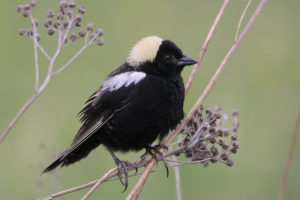Audubon and Ethanol
by Jerry Jung
 This year the EPA has mandated that 15 billion gallons of ethanol be added to gasoline. Most gasoline contains about 10% ethanol. It is a relatively cheap way for refineries to increase the octane rating—cheap that is if environmental degradation and large agricultural subsidies are not factored in. Often I am asked why I started a website titled “Rethink Ethanol.” It all started a few years ago at my hobby farm north of Clare, Michigan. I try to spend a day or two there every month of the year, because as we all know, nature presents different sides of herself as the seasons change. Late May is one of my favorite times because that is when the Bobolinks and monarch butterflies return to the property. A few dozen bob-o-links descend on the hayfields and until about 7 years ago I could depend on seeing hundreds of monarchs clustered around the lilac bushes planted alongside the two-track leading into the woods. The last couple of years, the monarchs have not arrived.
This year the EPA has mandated that 15 billion gallons of ethanol be added to gasoline. Most gasoline contains about 10% ethanol. It is a relatively cheap way for refineries to increase the octane rating—cheap that is if environmental degradation and large agricultural subsidies are not factored in. Often I am asked why I started a website titled “Rethink Ethanol.” It all started a few years ago at my hobby farm north of Clare, Michigan. I try to spend a day or two there every month of the year, because as we all know, nature presents different sides of herself as the seasons change. Late May is one of my favorite times because that is when the Bobolinks and monarch butterflies return to the property. A few dozen bob-o-links descend on the hayfields and until about 7 years ago I could depend on seeing hundreds of monarchs clustered around the lilac bushes planted alongside the two-track leading into the woods. The last couple of years, the monarchs have not arrived.
Perplexed, I started to do some research. It turns out that monarch populations have plummeted 95% in recent years. Farming practices have a lot to do with it as corn seeds in the U.S. are now coated with “neo-nics” that spread throughout the plant and are deadly toxic to pollinators. Roundup Ready GMO corn and soybeans allow farmers to eliminate virtually all “weeds.” The biggest culprit, however, is all the extra acreage being planted in corn. On a recent motorcycle ride through eastern Colorado, Nebraska and Iowa, I was shocked at how much land is being dedicated to growing corn. Those states have become one big factory farm with corn being grown right up unto the shoulders of rural roads. Hand painted signs read, “Family Farms, not Factory Farms.” In Iowa for instance, 99.9% of long grass prairie no longer exists. Rather than supporting 400 plus species of plants, most of this land supports only toxic corn. So it’s not hard to understand why monarchs can’t survive the migration from Mexico.
 Why so much corn? Of the 90 million acres of corn planted in this country, a full 40% is grown to be made into ethanol. That’s more corn than is fed to livestock. The 36 million acres growing corn for ethanol exceeds the landmass of Michigan. Think of all the bio-diversity in Michigan—all the birds, wildlife and plants. That’s how much nature the ethanol mandate destroys. More than that if you consider the impact on migrating species and the extensive water pollution due to agriculture run-off. (Remember the toxic algae in Lake Erie?) Organizations like Detroit Audubon, on hearing the facts, agree that the EPA mandate creates “… additional stress for many wildlife species that are already struggling, like grassland birds and the monarch butterfly….”. They support a complete rollback of all corn-based ethanol mandates and subsidies.
Why so much corn? Of the 90 million acres of corn planted in this country, a full 40% is grown to be made into ethanol. That’s more corn than is fed to livestock. The 36 million acres growing corn for ethanol exceeds the landmass of Michigan. Think of all the bio-diversity in Michigan—all the birds, wildlife and plants. That’s how much nature the ethanol mandate destroys. More than that if you consider the impact on migrating species and the extensive water pollution due to agriculture run-off. (Remember the toxic algae in Lake Erie?) Organizations like Detroit Audubon, on hearing the facts, agree that the EPA mandate creates “… additional stress for many wildlife species that are already struggling, like grassland birds and the monarch butterfly….”. They support a complete rollback of all corn-based ethanol mandates and subsidies.
Don’t be fooled by special interest campaigns promoting ethanol. Corn ethanol takes as much fossil fuel to produce as it yields. It makes no economic sense and it is an environmental disaster contributing in a major way to what has aptly become known as the sixth extinction*.
* Elizabeth Kolbert, The Sixth Extinction: An Unnatural History, (Henry Holt & Company, 2014)
